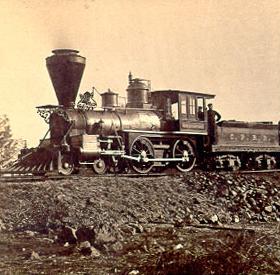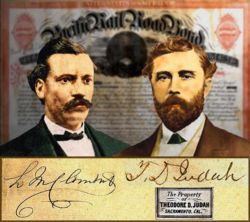Central Pacific Railroad
| Central Pacific Railroad | |
|---|---|
| Locale | Sacramento, CA-Ogden, Utah |
| Dates of operation | 1863 – April 1 1885 but continued as SP Leased Line |
| Track gauge | 4 ft 8½ in (1435 mm) (standard gauge) |
| Headquarters | Sacramento, CA; San Francisco, CA |

The Central Pacific Railroad was the California-to-Utah portion of the First Transcontinental Railroad in North America. Many proposals to build a transcontinenal failed because of the disputes over slavery in Washington; with the secession of the South, the modernizers in the Republican party took over Congress and passed the necessary legislation and subsidies. It was planned by Theodore Judah, authorized by Congress in 1862 and financed and built through "The Big Four" (who also called themselves "The Associates"), who were Sacramento, California businessmen Leland Stanford, Collis Huntington, Charles Crocker, and Mark Hopkins. Crocker was in charge of construction; much of the labor were Chinese workers. The first rails were laid in 1863 and the golden spike, connecting it to the Union Pacific railroad to Omaha, was hammered on May 10, 1869. Coast-to-coast travel in 8 days now replaced wagon trains or months-long sea voyages.
The road was built with loans from major financial centers, backed by land grants and subsidies. The federal government gave away land-grants in a checkerboard pattern. The railroad sold every-other square. The government also loaned money--later repaid--at $16,000 per mile on level stretches, and $32,000 to $48,000 in mountainous terrain. Local and state governments also aided the financing.
In 1885 the Central Pacific Railroad was leased by the Southern Pacific, though it technically remained a corporate entity until 1959 when it was formally merged into Southern Pacific. The original right of way is now part of the Union Pacific which purchased Southern Pacific in 1996.
The first "transcontinental", the Union Pacific-Central Pacific (Southern Pacific) mainline made up the historic "Overland Route" from Omaha to San Francisco Bay.
Contents
Museums and archives
A replica of the Sacramento, California Central Pacific Railroad passenger station is part of the California State Railroad Museum, located in the Old Sacramento State Historic Park. Two of the company's first locomotives, the Gov. Stanford (No. 1), and C. P. Huntington (No. 3), are also both housed at the same museum.
Nearly all of the company's early correspondence is preserved at Syracuse University as part of the Huntington papers collection, released on microfilm (133 reels). The following libraries have this microfilm: University of Arizona at Tucson; Virginia Commonwealth University at Richmond. Additional collections of manuscript letters are held at Stanford University and the Mariner's Museum at Newport News, Virginia. Alfred A. Hart was the official photographer of the CPRR construction.
Timeline
- June 211861: "Central Pacific Rail Road of California" incorporated; name changed to "Central Pacific Railroad of California" October 8, 1864, after the Pacific Railway Act amendment passes that summer.
- July 11862: President Lincoln signs the Pacific Railway Act, which authorized the Central Pacific and the Union Pacific to build a railroad to the Pacific Ocean.
- January 8 1863: Ground breaking ceremonies take place at Sacramento, California, at the foot of "K" Street at the waterfront of the Sacramento River.[1]
- October 26 1863: First rail laid, at Sacramento.
- April 26 1864: Central Pacific opened to Roseville, 18 miles, where it makes a junction with the California Central Rail Road, operating from Folsom north to Lincoln.
- June 3 1864: The first revenue train on the Central Pacific operates between Sacramento and Newcastle, California
- October 8 1864: Following passage of the amendment to the Pacific Railroad Act, the company's name is changed to "Central Pacific Railroad of California," a new corporation.
- May 13 1865: Central Pacific opened 36 miles to Auburn, California.
- September 1 1865: Central Pacific opened 54 miles to Colfax, California (formerly known as "Illinoistown.")
- December 3 1866: Central Pacific opened 92 miles to Cisco, California.
- December 1 1868: Central Pacific opened to Summit of the Sierra Nevada, 105 miles.
- April 28 1869: Track crews on the Central Pacific lay 10 miles of track in one day. This is the longest stretch of track that has been built in one day to date.
- May 10 1869: The Central Pacific and Union Pacific tracks meet in Promontory, Utah.
- May 15 1869: The first transcontinental trains are run over the new line to Sacramento.
- November 8 1869: The Central Pacific completes the final leg of the route, connecting Sacramento to Oakland.
- June 23 1870: Central Pacific is consolidated with the Western Pacific and San Francisco Bay Railroad Co. to form the "Central Pacific Railroad Co." (of June, 1870).
- August 22 1870: Central Pacific Railroad Co. is consolidated with the California & Oregon; San Francisco, Oakland & Alameda; and San Joaquin Valley Railroad; to form the "Central Pacific Railroad Co.", a new corporation.
- April 30 1876: Operates the California Pacific Railroad between South Vallejo and Sacramento, Calistoga and Marysville until April 1, 1885 (see below).
- July 16 1877: Start of the Great Railroad Strike of 1877 when railroad workers on strike in Martinsburg, West Virginia, derail and loot a train; United States President Rutherford B. Hayes calls in Federal troops to break the strike.
- November 18 1883: A system of one-hour standard time zones for American railroads was first implemented. The zones were named Intercolonial, Eastern, Central, Mountain, and Pacific. Within one year, 85% of all cities having populations over 10,000, about 200 cities, were using standard time.
- April 1 1885: Central Pacific is leased to Southern Pacific.
- June 30 1888: Listed by ICC as a "non-operating" subsidiary of Southern Pacific.
- July 29 1899: Central Pacific is reorganized as the "Central Pacific Railway".
- June 30 1959: Central Pacific is formally merged into the Southern Pacific.
Predecessor railroads
References
- General
- Ambrose, Stephen E. (2000). Nothing Like It In The World; The men who built the Transcontinental Railroad 1863-1869. Simon & Schuster. ISBN 0-684-84609-8.
- David Haward Bain, Empire Express: Building the First Transcontinental Railroad (2000)
- Cooper, Bruce C., "Riding the Transcontinental Rails: Overland Travel on the Pacific Railroad 1865-1881" (2005), Polyglot Press, Philadelphia ISBN 1-4115-9993-4
- Cerinda W. Evans; Collis Potter Huntington Vol. 1 Mariners Museum, 1954
- Fleisig, Heywood. "The Central Pacific Railroad and the Railroad Land Grant Controversy" Journal of Economic History 1975 35(3): 552-566. ISSN 0022-0507 Fulltext in JSTOR. Questions whether promoters of the Central Pacific Railroad were oversubsidized. Confirms the traditional view that subsidies were not an economic necessity because they "influenced neither the decision to invest in the railroad nor the speed of its construction." Notes that estimates of rate of return for the railroad developers using government funds range from 71% to 200%, while estimates of private rates of return range from 15% to 25%.
- John Debo Galloway; The First Transcontinental Railroad: Central Pacific, Union Pacific (1950)
- Kraus, George. "Chinese Laborers and the Construction of the Central Pacific." Utah Historical Quarterly 1969 37(1): 41-57. ISSN 0042-143X. Shows how Chinese railroad workers lived and worked, how they managed the finances associated with their employment, and concludes that Central Pacific officials responsible for employing the Chinese, even those at first opposed to the policy, came to appreciate the cleanliness and reliability of this group of laborers. There are many quotations from accounts by contemporary observers.
- Lake, Holly. "Construction of the CPRR: Chinese Immigrant Contribution" Northeastern Nevada Historical Society Quarterly 1994 94(4): 188-199. ISSN 0160-9602
- Mercer, Lloyd J. "Rates of Return for Land-grant Railroads: the Central Pacific System" Journal of Economic History 1970 30(3): 602-626. ISSN 0022-0507 Fulltext in JSTOR. Analyzes the impact of land grants, during 1864-90, on rates of return from investment in the Central Pacific Railroad. Results suggest that even without land grants, rates of return were high enough to induce investment. Also, land grants did not pay for the construction of the railroad. Land grants, however, did produce large social returns in western states by accelerating construction of the system.
- Mercer, Lloyd J. "Land Grants to American Railroads: Social Cost or Social Benefit?" Business History Review 1969 43(2): 134-151. ISSN 0007-6805 Fulltext in Jstor. Attempts by the use of econometrics to determine the values of railroad land grants of the 19th century to the railroads and to society as a whole. The author summarizes and criticizes previous treatments of this subject and then discusses his own findings. Using only the Central Pacific and the Union Pacific systems as the basis for his investigation, the author concludes that the railroad owners received unaided rates of return which substantially exceeded the private rate of return on the average alternative project in the economy during the same period. Thus the projects turned out to be profitable although it was generally expected by contemporary observers that the roads would be privately unprofitable without the land grant aid. The land grants did not have a major effect, increasing the private rate of return only slightly. Nevertheless, it is contended that the policy of subsidizing those railroad systems was beneficial for society since the social rate of return from the project was substantial and exceeded the private rate by a significant margin.
- Ong, Paul M. "The Central Pacific Railroad and Exploitation of Chinese Labor." Journal of Ethnic Studies 1985 13(2): 119-124. ISSN 0091-3219. Ong tries to resolve the apparent inconsistency in the literature on Asians in early California, with contradictory studies showing evidence both for and against the exploitation of Chinese labor by the Central Pacific Railroad, using monopsony theory as developed by Joan Robinson. Monopsonists are buyers whose share of the market is large enough to affect prices, or whose supply curves are not completely elastic. By setting different wages for whites and Chinese - each having different elasticities of supply - and using Chinese in the menial and dangerous jobs, with whites in the better positions, the two groups were complementary rather than interchangeable. Calculations thus prove higher levels of exploitation of the Chinese than in previous studies.
- Saxton, Alexander. "The Army of Canton in the High Sierra" Pacific Historical Review 1966 35(2): 141-151. ISSN 0030-8684 on Chinese workers.
- Tutorow, Norman E. "Stanford's Responses to Competition: Rhetoric Versus Reality." Southern California Quarterly 1970 52(3): 231-247. ISSN 0038-3929 Leland Stanford and the men who ran the Central Pacific Railroad system paid lip-service to the idea of free competition but in practice sought to destroy or weaken competing railroad and shipping lines. Focusing on the years between the completion of the first transcontinental railroad line (1869) and Stanford's death (1893), the author shows how Stanford and the Central Pacific associates repeatedly entered into pooling arrangements to prevent competition, brought out competitors, or forced rivals to agree not to compete with them. He concludes that Stanford and his partners viewed laissez-faire as applicable only to government controls and not to destruction of competition within the system by those involved
- White, Richard, "Information, Markets, and Corruption: Transcontinental Railroads in the Gilded Age". The Journal of American History 90.1 (2003)
- Williams, John Hoyt. A Great and Shining Road: The Epic Story of the Transcontinental Railroad (1988)
- Goodwin, Neil, prod. The Iron Road. Video. Color. 58min. (American Experience series.) Publication: Peace River Films, 1990. Distrib. by PBS Video
- Specific
- ↑ Ambrose, Stephen E. (2000). Nothing Like It in the World (paperback), New York, NY: Simon & Schuster, p 106. ISBN 0-7432-0317-8.
See also
External links
| Central Pacific Railroad | The Big Four | Charles Crocker | Mark Hopkins | Collis P. Huntington | Leland Stanford |

